Related Research Articles
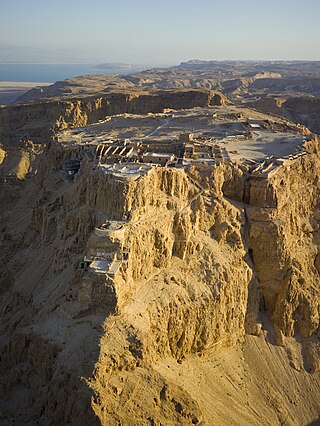
Masada is an ancient fortification in southern Israel, situated on top of an isolated rock plateau, akin to a mesa. It is located on the eastern edge of the Judaean Desert, overlooking the Dead Sea 20 km (12 mi) east of Arad.

Zechariah is a Jewish figure in the New Testament and the Quran, and venerated in Christianity and Islam. In the Bible, he is the father of John the Baptist, a priest of the sons of Aaron in the Gospel of Luke, and the husband of Elizabeth who is a relative of the Virgin Mary.

The James Ossuary is a 1st-century limestone box that was used for containing the bones of the dead. An Aramaic inscription meaning "Jacob (James), son of Joseph, brother of Yeshua" is cut into one side of the box. The ossuary attracted scholarly attention due to its apparent association with the Christian holy family.
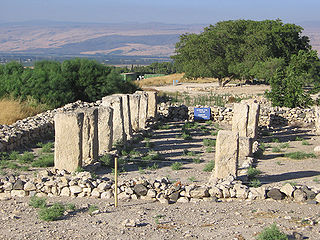
Tel Hazor, also Chatsôr, translated in LXX as Hasōr, named in Arabic Tell Waqqas / Tell Qedah el-Gul, is an archaeological tell at the site of ancient Hazor, located in Israel, Upper Galilee, north of the Sea of Galilee, in the northern Korazim Plateau. From the Middle Bronze Age to the Iron Age, Hazor was the largest fortified city in the region and one of the most important in the Fertile Crescent. It maintained commercial ties with Babylon and Syria, and imported large quantities of tin for the bronze industry. In the Book of Joshua, Hazor is described as "the head of all those kingdoms". Though scholars largely do not consider the Book of Joshua to be historically accurate, archaeological excavations have emphasized the city's importance.

The Tomb of Absalom, also called Absalom's Pillar, is an ancient monumental rock-cut tomb with a conical roof located in the Kidron Valley in Jerusalem, a few metres from the Tomb of Zechariah and the Tomb of Benei Hezir. Although traditionally ascribed to Absalom, the rebellious son of King David of Israel, recent scholarship has dated it to the 1st century AD.
A nefesh is a Semitic monument placed near a grave so as to be seen from afar.

David Ussishkin is an Israeli archaeologist and professor emeritus of archaeology.

The Israel Exploration Society (IES), originally the Jewish Palestine Exploration Society, is a society devoted to historical, geographical and archaeological research of the Land of Israel. The society was founded in 1913 and again in 1920, with the object of studying the history and civilization of the Land of Israel and of disseminating its knowledge.

Simcha Jacobovici is a Canadian-Israeli journalist, documentary filmmaker and pseudoarcheologist.
James Daniel Tabor is an American Biblical scholar and retired Professor of Ancient Judaism and Early Christianity in the Department of Religious Studies at the University of North Carolina at Charlotte, where he taught from 1989 until 2022 and served as chair from 2004 to 2014. He previously held positions at Ambassador College, the University of Notre Dame (1979–85), and the College of William and Mary (1985–89). Tabor is the founder and director of the Original Bible Project, a non-profit organisation aimed to produce a re-ordered new translation of the Bible in English.

Nahman Avigad, born in Zawalow, Galicia, was an Israeli archaeologist.

The Talpiot Tomb is a rock-cut tomb discovered in 1980 in the East Talpiot neighborhood, five kilometers south of the Old City in East Jerusalem. It contained ten ossuaries, six inscribed with epigraphs, including one interpreted as "Yeshua bar Yehosef", though the inscription is partially illegible, and its translation and interpretation is widely disputed. The tomb also yielded various human remains and several carvings.

The Lost Tomb of Jesus is a pseudoarchaeological docudrama co-produced and first broadcast on the Discovery Channel and Vision TV in Canada on March 4, 2007, covering the discovery of the Talpiot Tomb. It was directed by Canadian documentary and film maker Simcha Jacobovici and produced by Felix Golubev and Ric Esther Bienstock, while James Cameron served as executive producer. The film was released in conjunction with a book about the same subject, The Jesus Family Tomb, issued in late February 2007 and co-authored by Jacobovici and Charles R. Pellegrino. The documentary and the book's claims have been rejected by the overwhelming majority of leading experts within the archaeological and theological fields, as well as among linguistic and biblical scholars.
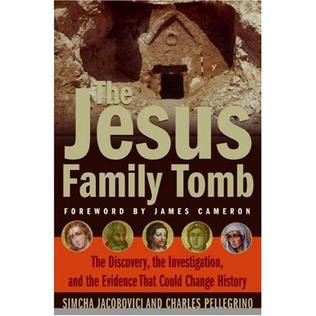
The Jesus Family Tomb: The Discovery, the Investigation, and the Evidence That Could Change History (ISBN 0061192023) is a controversial book by Simcha Jacobovici and Charles R. Pellegrino published in February 2007. It tells the story of the discovery of the Talpiot Tomb on Friday March 28, 1980 and makes an argument that it is the tomb of Jesus Christ and his family.

Ehud Netzer was an Israeli architect, archaeologist and educator, known for his extensive excavations at Herodium, where in 2007 he found the tomb of Herod the Great; and the discovery of a structure defined by Netzer as a synagogue, which if true would be the oldest one ever found.
The Naked Archaeologist is a television series on VisionTV in Canada and History International in the US, that was produced and hosted by the Emmy Award–winning journalist Simcha Jacobovici. There is also an Israeli version, broadcast on Channel 8 (Israel), that was co-hosted by Avri Gilad. The show examines biblical stories and tries to find proof for them by exploring the Holy Land looking for archaeological evidence, personal inferences, deductions, and interviews with scholars and experts.
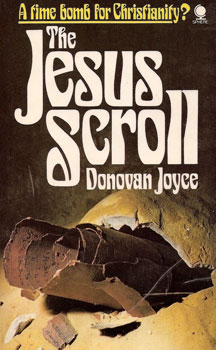
The Jesus Scroll is a best-selling book first published in 1972 and written by Australian author Donovan Joyce. A forerunner to some of the ideas later investigated in The Da Vinci Code, Joyce's book made the claim that Jesus of Nazareth may have actually died aged 80 at Masada near the Dead Sea, site of the last stand made by Jewish zealot rebels against the Roman Empire, after the Fall of Jerusalem and the destruction of the Second Temple.

Jodi Magness is an archaeologist, orientalist and scholar of religion. She serves as the Kenan Distinguished Professor for Teaching Excellence in Early Judaism at the University of North Carolina at Chapel Hill. She previously taught at Tufts University.
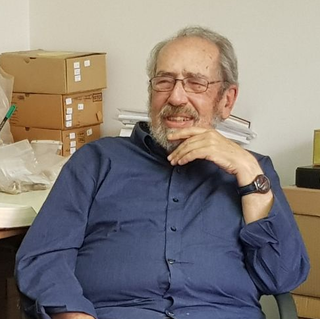
Gabriel Barkay is an Israeli archaeologist.

Megiddo church, near Tel Megiddo, Israel, is an archaeological site which preserves the foundations of one of the oldest church buildings ever discovered by archaeologists, dating to the 3rd century AD. The ‘Megiddo Church’, as the room became known, was dated to circa 230 AD on the basis of pottery, coins, and the inscriptional style. The site’s abandonment, circa 305 AD, is evident in the purposeful covering of the mosaic, and relates well to the crisis of 303 AD, when the Christian communities of Judea experienced the Diocletianic Persecution.
References
- 1 2 "Meet Joe Zias". CenturyOne Foundation. 2004. Archived from the original on 11 February 2012. Retrieved 6 December 2011.
- ↑ Zias, Joe. "Curriculum vitae". Joe Zias - Science and Archaeology Group. Archived from the original on 12 July 2012. Retrieved 10 July 2021.
- ↑ Zias, Joe Edward; Puech, Émile (December 2005). "The Tomb of Absalom Reconsidered". Near Eastern Archaeology . 68 (4): 149–165. doi:10.1086/NEA25067622 . Retrieved 8 August 2021.
- ↑ Vergano, Dan (6 April 2004). "Controversy revisits Shroud of Turin". USA Today. Gannett Company. Archived from the original on 20 July 2013. Retrieved 10 July 2021.
- 1 2 Myre, Greg (7 November 2005). "Israeli Prisoners Dig Their Way to Early Christianity". New York Times. Retrieved 6 December 2011.
- 1 2 "Israeli Scientists: Masada Bodies Are Roman, Not Jewish". Fox News. NewsCorp. Associated Press. 25 June 2007. Archived from the original on 4 March 2009. Retrieved 10 July 2021.
- ↑ Medved, Michael (11 March 2007). "Scene 1: Discredit religion; Scene 2: See Scene 1". USA Today . Gannett Company. Retrieved 6 December 2011.
- ↑ Winer, Stuart (9 June 2015). "'Naked Archaeologist' Jacobovici wins libel case". The Times of Israel. Archived from the original on 4 April 2021. Retrieved 10 July 2021.
- ↑ Reiner, Reggie (14 June 2015). "Simcha Jacobovici Wins Lawsuit Over Jesus Tomb". Jewish Business News. Archived from the original on 18 January 2021. Retrieved 10 July 2021.